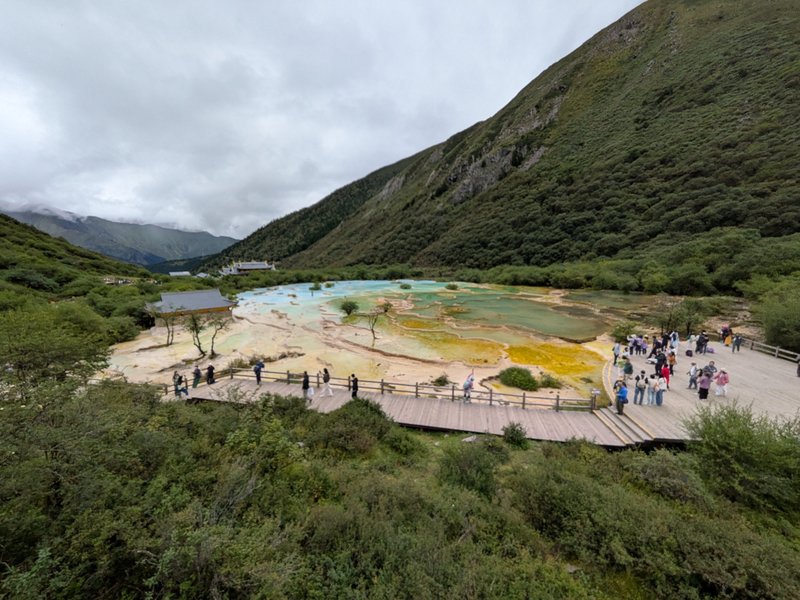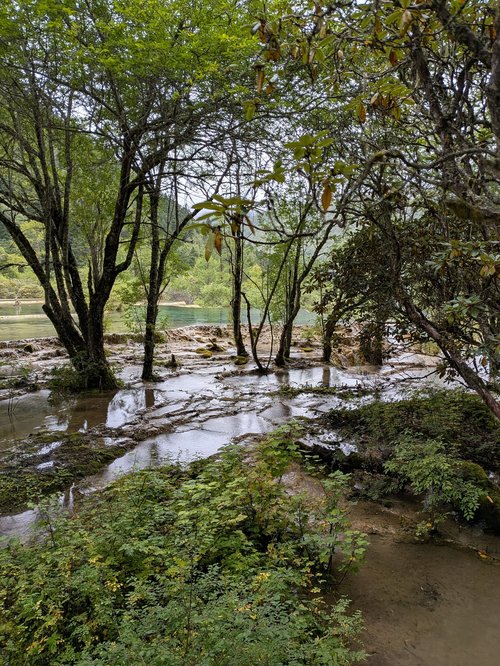Our initial glimpses of Huanglong were, truth be told, a touch anticlimactic. We'd ascended via the cable car and found ourselves on the first viewing platform. Compared to the turquoise pools of Jiuzhaigou the day prior, it all looked rather small and decidedly brownish. The day's cloudy weather probably didn't help.
Eventually, we reached the cascades. From there, it's a climb to reach Wucai (Five-Colour) Pond and the primary temple, Huanglong Ancient Temple. Even at this stage, the views hadn't quite grabbed me.

It was only as we began the descent that the site truly started to come into its own. The water tumbles downhill through a myriad of calcite pools and cascades. The Chinese authorities have done a superb job of creating boardwalks, allowing you to walk right alongside—or, indeed, directly over—the water flows.
If you compare Jiuzhaigou to Huanglong, I found Jiuzhaigou the richer experience while cascades at Huanglong are the more outstanding individual feature. The other obvious comparison also made by Els is to the pools at Pamukkale. Huanglong, however, feels far more like a natural site, and the environment seems better preserved than its Turkish counterpart. Given the Taoist temples on site and the Taoist significance, I was wondering if this shouldn't be a mixed site.
Getting There
Thanks to the high-speed rail connection to Chengdu, a day trip is technically possible, making it an addition to your Chengdu Hotspot. However, it's not a terribly sensible option, as you really ought to visit the nearby Jiuzhaigou, which requires an overnight stay.
From the train station, you can hop on a bus. Alternatively, you can arrange a private transfer (via a service like Didi or Trip.com). The journey to the entrance takes about an hour.
Most visitors opt for the uphill cable car ticket. A shuttle bus connects the main entry point to the cable car station. From the upper cable car station, we'd recommend taking another shuttle, as the walking path to the pools is frankly uneventful, with only one viewing platform en route.
For those travelling to or from Jiuzhaigou, there's a left luggage service next to the ticket office in a small cabin.
Getting Tickets
You can, and absolutely should, purchase your ticket online. For international visitors, trip.com is usually the easiest option. You then gain entry by presenting your passport. Note: You must use the English version of the Trip.com site; we found the tickets weren't listed on the German version.
Hiking

Most people take the cable car up and then descend alongside the water flow. The boardwalk trail closely follows the flow of the water, allowing you to appreciate the full range of colours and formations. You really need to walk the entire path to see everything. We spent a total of four hours from arrival to departure.
Altitude Sickness
The site reaches altitudes of 3,700 metres, and you will be exerting yourself as there is some uphill walking left after leaving the cable car. Be mindful of the risk of altitude sickness. Should you start to feel unwell, there are oxygen cabins available along the trail. You can also purchase portable oxygen sprays.
A word of warning: DO NOT take these oxygen sprays into the train station.
While You're There
Most visitors (ourselves included) only visit the first component of the site—the pools. However, Mounigou (Valley), the other location, sounds rather intriguing, too, with the main waterfall being mentioned.
A trip to the nearby Jiuzhaigou is a must. And, depending on your wider travel plans, you might consider adding a stop at Maoxian to see the Diaolou watchtowers (see my Jiuzhaigou review).
Comments
No comments yet.
